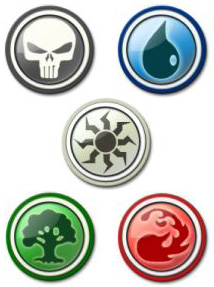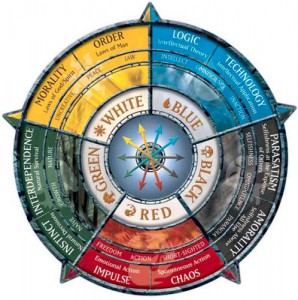Burstback: the Return of Manaburst
 The members of my Saturday gaming group are all adults with busy lives so it’s no surprise that most Saturdays at least one person winds up being late for our weekly session. Instead of starting our sessions early and having to catch people up, we’ve recently started breaking out some Magic decks and playing a few games to pass the time.
The members of my Saturday gaming group are all adults with busy lives so it’s no surprise that most Saturdays at least one person winds up being late for our weekly session. Instead of starting our sessions early and having to catch people up, we’ve recently started breaking out some Magic decks and playing a few games to pass the time.
During one of our games a player mentioned that he thought a role-playing game set in a heavily Magic-inspired setting would be a lot of fun, but that playing beings like planeswalkers didn’t seem like it would work. He was surprised when I replied that not only did I think it would work fine, I had done it before.
I’m not about to usurp the Earthdawn game we have running – I enjoy it too much. But with the interested around the table it seems like it might be time to break out my Manaburst notes and look at making some revisions. I’ve already started getting ideas on how to improve over our first attempt.
The first change that I’m going to have to make is stepping away from the visual/narrative Everway-style task resolution system to something more traditional. Judging by my last attempt and knowing the members of this group, I think that a system with a little more structure would go a long way to making the game play smoother.
To that end I’m leaning towards using FATE as the core mechanic this time around. It has a more rigid structure than Everway but there’s still enough of a narrative aspect to let players maintain a high fantasy feel through descriptive actions. FATE has the structure I want for this game, but it using it will create three problems I’m going to need to work through to make the system fit Magic’s cosmology.

1. 5-Color Magic
The problem of 5-color magic is twofold. First and foremost, Spirit of the Century (and Diaspora as well) really don’t have complex magic systems. A MtG-style magic system wasn’t necessary for either system for obvious reasons so wasn’t created. That means a design from the ground up. I’ll definitely be begging, borrowing, and stealing as I go but one way or another I’m going to have to add a system to the basic FATE rules.
The second issue is one of distinctness. In a non-MtG style game, a magic system could be simplified by letting players perform Maneuvers using a magic skill to apply Aspects to their target or perform a task. In fact this could work for Manaburst as well, but a completely open magic system would create a situation like this:
DM: Each of you arrive at a separate corner of the island. In front of you is a locked and barred wooden door. Behind each door is a passage to the underground chamber you all want to be the first to find. What do you do?
White Mage: It’s the will of the heavens that I reach the chamber first. Divine Mandate will open them for me!
Blue Mage: Probe the locking mechanism with divinations to discern their inner workings and ultimately undo them!
Black Mage: Rot the door from its hinges in a sickly haze!
Red Mage: Blow the door apart with a fireball!
Green Mage: Summon a rampaging beast to batter the door down for me!
It’s easy to look at the other four replies and think “Cool, everyone can show off their own flavor of magic!” And that could work just fine, but in my opinion there’s an associated shortcoming. I feel that each color of magic should be distinct in at least some of its effects. A Red Mage should just be able to do things that a Blue Mage just can’t. Otherwise color just becomes a flavorful descriptor. That may work fine from a narrative aspect, but if anyone is in the party is a mage, there’s the potential for players to feel frustrated by not being able to stand out in what they can do.
I want every mage to be distinct; to feel like they offer something to the group that the others do not. I’m tempted to go so far as to make characters choose a specialization or theme within each color they have to stick with. They could purchase additional specializations (within the same or different color), but that would cost them more of a yet undefined character-build resource. That would also allow multiple mages of the same color to remain distinctness as well. Example specialties might include:
- Purity of Light (White) – Restoration and cleansing effects and angelic creatures
- Dissonance of Thought (Blue) – Mental effects and illusory creatures
- Evershifting Tides (Blue) – Misdirection effects and aquatic creatures
- Stench of the Grave (Black) – Fear and decay effects and undead creatures
- Unholy Pact (Black) – Corruption and/or otherworldly effects and abyssal creatures
2. Color-Influenced Attributes
This one is a biggie. The original Manbrust rule turned each of the colors of magic into an attribute and derrived skills from those. That worked fine for that game, but after looking at the skill pyramid in FATE and how it ties to everything else, I’m going to have to take a different approach for this game.
My first thought was just to make a separate mana-pyramid in addition to the regular skill pyramid, but that just gives the players more skills and will promote multi-color mages. I want that to be possible, but as the exception instead of the norm. It also adds complexity to the system I don’t think it needs.
My second thought – and what I’m leaning towards at the moment – is to have each color of magic be a separate skill which they have to fit on their skill tree. I might even break each color into summoning and sorcery for more variance in aptitudes. My only regret is losing the way Manaburst ties every stat to a mana color, but in the long run I think this will be easier to manage.
That leaves stunts though. How to I handle those, or do I just remove them completely? I might use them as the gateway – a character needs a stunt for each flavor/specialization (see above) they intend to use.
I’m not sure I like that though. The names I’ve started coming up for for specializations sound like Aspects to me. I’d like to be able to make them into Aspects, but I don’t think that’s mechanically a good idea. If you have to have a specific Aspect to perform a certain spell, you shouldn’t automatically be able to tag that same Aspect for a bonus. That pushes me back towards Stunts as the “gateway” to spellcasting, but I’m going to see what other systems I can find online.
3. Incorporating MtG Cards?
I’m not sure if this is going to make it into the final version, but I’m tempted to see if we can find a way to work MtG cards into the mechanic at some point. In the original Manaburst, they were the random aspect of task resolution, but the Fudge dice are going to do that here. I might give a player a +1 to any roll to cast a spell they have a card that represents it, or summon a creature they have a card they can represent it visually.
I can really appreciate this visual aspect, but I’m worried about it overshadowing the game; either constraining players to only think of what is in their card collections, or even penalizing those who only have a small number of cards. That’s definitely something I want to avoid, which might mean I drop this concept before all’s said and done.
The TL;DR?
One of my biggest challenges is going to make sure there’s some of the flavor from the card game maintained, but it can’t overwhelm the role-playing aspect. Looks like I’ve got a lot of work ahead of me.
Well, you have my attention with this. I never read your original stuff. But sounds like you have a good idea working. I’d have to see what you have in a more finalized version to see how well I’d like it.